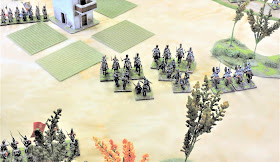Just over 45 years ago, the Yom Kippur War broke out.
I was in junior high at the time and was already reading about the tank battles of North Africa during World War II. So in addition to reading history, the October War sparked my interest into keeping up with world affairs. This of course all led to wargaming.
Fast forward to the early part of this year: My friend Joe and I managed to get-together and play a few turns of Golan: The Last Syrian Offensive. (Although my copy, printed in 2010, is titled--Golan: The Syrian Offensive).
This is one in Decision Games' Folio Series.
Within Golan's folio is a map (12" x 22"), one 8-page Folio Standard Rule Book, one 4-page Exclusive Rule Book, and 100 die-cut counters.
Golan is a two-player game representing the initial Syrian attack during the Yom Kippur War to be played within 1-2 hours. The Complexity Rating is considered low, but has a high solitaire suitability. Unit counters represent battalion, regiment or brigade forces while each hex on the map represents 2 kilometers (1.25 miles).
The After Action Review of the Initial Phases of the Syrian Offensive
Four Syrian Divisions, the 3rd, 7th, and 9th Mechanized, along with the 1st Armored Division, mass in assembly areas just beyond the DMZ.
Meanwhile, elements of the Israeli 11th and 19th Mechanized Brigades occupy outposts along the Demilitarized Zone (DMZ) centered around the towns of Ahmediye and Boutmiya.
On 6 October 1973, the Syrian 7th and 9th Mechanized Divisions pour across the DMZ border near Ahmediye, and engage two Israeli battalions (one from the 11th and 19th Brigade), who are supported by the 71st Tank Battalion.
While near Boutmiya, elements of the Syrian 3rd Division engage the three Israeli battalions picketed there (two from the 11th and one from the 19th Brigade).
Both sides quickly call for fire support. In the opening engagement, 10 kilometers (kms) west of Ahmediye, the Syrian 7th Infantry Brigade and the Israeli 71st Tank Battalion sustain heavy casualties.
As the Syrian forces to the west of Ahmediye regroup to renew their advance, the focus shifts on dislodging the Israeli 10th Mechanized Infantry Battalion hunkered-down in the village itself. The Syrians call-in heavy artillery and rocket batteries, while two flights of Israeli F-4 Phantoms attempt to provide close air support for the beleaguered defenders.
Unfortunately, the Israeli aircraft draw attention from three Syrian SA-2 batteries.
The volley of Surface-to-air missiles surprise the Israeli pilots and two F-4s are shot down.
Despite the loss of vital aircraft, the Israeli defense inflicts heavy casualties on the Syrian 8th Brigade/9th Infantry Division.
Despite the Syrians' set-back at Jukhadar, they continue their attack on the Israeli positions around Boutmiya. The Syrian attack is supported by two batteries of heavy artillery, while the Israeli defense is supported by two flights of F-4s.
Syrian reinforcements approach the DMZ border on the weak Israeli western flank.
Both sides pour-in massive fire support for the battle still raging around the fort at Ahmediye.
Masada is captured by the Syrian 11th Armored Brigade/7th Mechanized Division, as the entire Syrian 1st Armored Division crosses the DMZ, while the Syrian 1st Paratroop Brigade captures another Israeli hilltop fort.
The Israeli 71st Armored Battalion is wiped out, leaving the 21st Mechanized Battalion to hold the collapsing western flank.
The last stand of the Israeli 21st Mechanized Battalion is short-lived, despite a fire-mission from heavy artillery, and an airstrike which is shot down by a salvo of SAMs.
Israeli reinforcements finally arrive and occupy key secondary positions...
...but will it be enough to stem The Syrian Offensive?
Concluding Notes
Joe and I didn't have enough time to run through the entire game and only played a few turns.
As the Israeli player, I committed two major mistakes.
The first was leaving my six battalions strung-out in forward positions along the DMZ. I should have retreated, or attempted to break contact with the Syrian forces right from the get-go, trading space for time.
The second error I committed was under estimating the effectiveness of the Syrian SAM umbrella. The fact that historically, the Israeli Air Force (IAF) made the same mistake provided me with little comfort. In game terms, a SAM battery isn't all that effective in-and of itself, needing a "6" on a six-sided die (1d6) to hit. But each IAF flight ended up being targeted by several SAM batteries simultaneously, which greatly improved Joe's odds of rolling a 6.
I lost half my aircraft within these first few turns. If I lost one more flight of aircraft, it would have degraded my ability to win if we played the entire game.
And while we're on the subject of supporting firepower: Howitzers, rocket launchers, mortars and air strikes are represented in an abstract manner. That is, there are no actual artillery batteries to move around on the map.
Joe didn't particularly care for this mechanic, because he had played an earlier version of this game that utilized specific artillery units. (Unfortunately, I can't seem to find any links to this on-line).
I thought it was a bit too abstract myself.
However, despite the need to get use to a healthy dose of abstraction, Golan: The (Last) Syrian Offensive is an inexpensive and quick way to spend time wargaming a modern military campaign.

































































